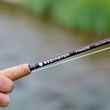A couple of summers ago, hunched over my tying vise high in the Caribou National Forest, I diverted from my usual Stimulator recipe and kind of went rogue. There were two reasons for my deviation. First, I realized that I’d finally reached an advanced enough age to where my eyesight — even with corrective lenses — was impacting my ability to see dry flies intended for the cutthroats I’d spent a couple of days chasing. Second, I’d just refilled a giant insulated cup with my third vodka and Sprite Zero cocktail, and my brain was just altered enough to consider something different.
So, as I sat at my camper’s cramped kitchen table, I had all the motivation I needed to make the next Stimulator I tied a fly for me, and not so much for the fish. The worst thing that could happen? The fish wouldn’t be interested in a gaudy, overdone dry fly and I’d spend the next morning casting and not catching much.
But then, about half-way through the altered rendition of the classic pattern, I realized that, regardless of what I did to the fly “topside,” the Stimmy’s admirable silhouette is what was going to matter to the trout taking a look at it from below. Generally tied to imitate an adult stonefly (and it was early July, just about when the little high-country creek’s salmonflies started to crawl out of the water in earnest), the Stimulator is a fairly easy tie at the vise. Most patterns are tied on larger hooks, which makes them even easier to craft, particularly for a guy like me who possesses larger hands and the manual dexterity of a box turtle.
And, like most dry flies, honestly, the above-water amenities are for the angler, not for the fish — save for maybe splayed out hackle for mayfly wings, or, in the case of a stonefly pattern, the fluffy elk or deer hair meant to imitate the big bug’s clumsy, translucent wings.
So, over the course of an hour or so, I continued playing around with the ingredients. Rather than neutral-toned elk hair, I went with an almost blonde color. For the body, instead of a drab dubbing, I tied in some bright green flash chenille. And for the head? A thin strip of bright orange foam wrapped to the hook-eye and palmered with grizzly hackle.
More Like This
I tied a few more, drained the cocktail and climbed into bed. Visions of beefy cutthroats rising to flies I could see from 30 feet away lulled me off to sleep. At the time, I thought they were gorgeous. But a new day and, well, sobriety, proved more critical. The heads were too long, the hackle too loose, and I don’t think I added enough elk hair for the wings. Nevertheless, on a bright day during the beginnings of a legit stonefly hatch, the shape was spot-on.
And, after rubbing in an appreciable amount of fly floatant on the first creation, I realized that I could, indeed, see the Stimulator, even among the foam and some other detritus that floated over the green water of the stream. And, thankfully, so could the stream’s naive native cutthroats.
It’s OK to tie flies for you
Certainly, some fly patterns tied for very specific waters or highly educated trout should be tied to represent the food in the water. Spring-creek trout that see hundreds of flies over the course of a couple of days are understandably more difficult to fool, and should likely be offered an exact (or as close to it as possible) rendition of the bugs in the water. Tailwater fish that get absolutely pounded are likely going to be picky and look for food sources that look as natural as possible.
But in many fly fishing instances, it’s almost as important for you to see the dry flies you’re casting as it is for the fish. In today’s world, where a hopper-dropper set-up is becoming more the rule rather than the exception, crafting a high-floating dry fly that you can undeniably see on the water is, dare I say, vital.
And, for smaller water, where trout don’t get as much pressure as their brethren on the more heralded rivers, anything that looks appreciably buggy is going to get a look. Tying a fly that has the right shape and the right silhouette might still be important. But, for most small-water and backcountry trout, the carpet doesn’t have to match the drapes.
Foam, Antron, even tinsel
So, for those of you like me, who might have some new and annoying visual challenges, be creative. You don’t require a purist’s blessing to go fly fishing. You’re not embarking on some noble venture. You’re trying to trick a creature with the brain the size of a pea into eating something that looks like it might just be food.
So sift through your tying materials and pick out a few ingredients that you might otherwise reserve for specialty tying. Pull out the craft foam and the brightly colored Antron yarn. Hell, grab the mylar tinsel (yes, it’s perfectly OK to use tinsel on dry fly), and start tying flies in the ant, beetle and hopper class.
And no, it doesn’t matter that it’s not “hopper season” yet, or that you’ve yet to see a beetle crawling through the willows. These are big bites of protein that trout eat opportunistically. And, some of these terrestrial bugs are around from the first few nice days of spring until the deep freeze hits in October.
Consider, too, that these flies may not be exactly what you’re using to catch fish. Tied correctly, they’re floating indicators, either for the ubiquitous hopper-dropper rig, or, for guys like me, as the front fly for a two-fly, dry-fly rig. Certainly, a size 6 Chernobyl isn’t going to get eaten as often when you’re fishing it during a Green Drake hatch, but the size 16 Adams — that drab and wonderful indicator that seems to match just about every mayfly hatch out there at any given time — might be exactly what the trout are after.
And if it’s floating two feet behind that Fat Albert with its loud-and-proud foam and Antron wings, chances are, you’re going to be able to find that smaller Adams on the water.
Loud and proud
Tying flies that are easier to see is but an adaptation in the aging angler’s fly fishing evolution. I mean, John McEnroe still plays tennis. Jack Nicklaus still swings a golf club. And, I bet, they still enjoy it, even if they have size down to a 3-iron or take on a doubles partner.
But tying visible flies doesn’t necessarily have to be the realm of anglers with old and tired eyes. For fly fishers who love the dry-fly experience — and who might be willing to sacrifice a few hookups they might otherwise get if they opted to go subsurface — fishing with flies that are easier to see just makes sense.
And, think about it. This isn’t some “new thing” dreamt up by a tipsy trout angler hanging out in his camper in the woods. We’ve been adding parachute posts to flies and foam tags to flies for decades, and, in most circumstances, this isn’t because trout like parachute posts or foam tags.
Fly fishers can be rigid and sometimes tradition and propriety can get in the way of a good day of fishing. The next time you sit down the vise, consider tying some flies for you. You might be surprised how much the trout like them, too.
































Comments
Jim G. Graham replied on Permalink
I could not agree more! I have tied similar concept flies with similar results....even with bourbon and caught fish. Thank you!
Pages